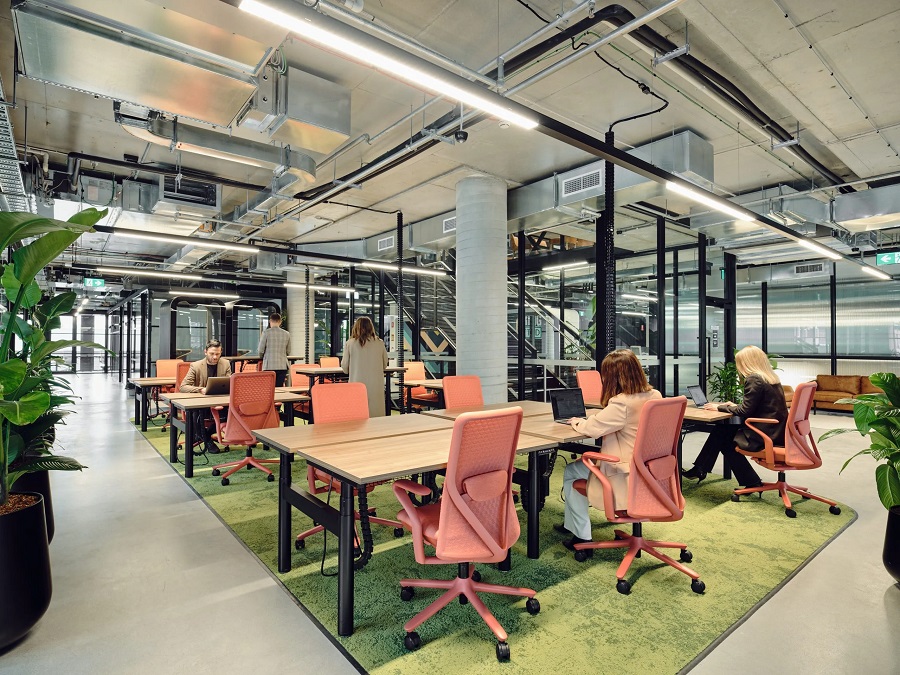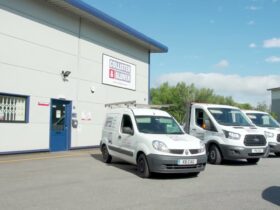Key Takeaways
- Flexible business spaces offer scalable, adaptable environments that allow companies to manage operational growth and changing requirements efficiently.
- Technology integration in flexible spaces enhances connectivity and collaboration, which is crucial for maintaining productivity across various working models.
- These spaces foster innovation and employee satisfaction, attracting top talent and ensuring a competitive edge in dynamic market conditions.
Introduction
In the contemporary world of fast-paced business, the hallmark of a successful company is scaling efficiently. As markets develop and competitors become more aggressive, enterprises face the challenge of being adaptable. Companies ready for growth but wary of conventional office lease agreements can find a solution in flexible business spaces. These dynamic settings foster an environment of innovation and collaboration by cultivating a culture of adaptability within the organization, meeting changing operational requirements, and encouraging proactive innovation. With the adoption of flexible workspaces, companies can transform growth strategies into sustainable and scalable goals.
The Advantages of Flexible Business Spaces
Business spaces with a flexible structure are remarkably versatile even compared to a dynamic office approach. Companies are no longer restricted by predefined design templates or space allocations contradicting their changing goals. Instead, flexible plans allow businesses to change spatial arrangements or resize their offices in real time to meet operational requirements. In addition to physical flexibility, flexible spaces often incorporate premium-grade, high-tech meeting rooms and ergonomic furnishings, which can be adjusted with different lease options. All these features combined offer a scalable solution that works with business expansion without incurring excess costs and optimizing space. Besides financial advantages, flexible spaces improve collaboration and creativity, leading to a more engaging and productive work environment. The option for short-term leases allows companies to experiment with different arrangements more freely, enabling responsiveness to change. Such spaces empower companies to rapidly scale their operations up or down in response to volatile market conditions without the finances associated with the stringent lease terms of traditional spaces. Moreover, the varying paneled options guarantee that businesses will find a space tailored to their vision as well as accommodate their workforce.
Flexible business spaces are a single-point, all-inclusive, and all-in-one solution that is multifaceted and adapts to changes within the approach to evolving with the shifts in the business world.
Leasing Flexible Space for Your Business
Flexible leasing arrangements and a proactive stance towards business agility while being financially mindful. Long-term leases can hinder strategic initiatives as business capital is tied down. Flexible leasing structures reduce these financial burdens, freeing up resources that can be better utilized in other areas. For companies interested in exploring flexible space leasing, it is beneficial to discover flexible business spaces at Birmingham’s Premier MicroFlex™ commercial properties, which offer diverse options tailored to unique business needs. Arrangements such as these help mitigate the consequences of market changes through controlled organic scaling.
These adaptable business strategies also provide further aid as recessions or surges in demand can be tackled smoothly without rising costs from explosive change management. Flexible leases are typically associated with lower initial expenditures, making reinvesting into business operations easier. This shift fosters a dynamic work environment, enabling unrestricted innovation and collaboration. As such, those focused on flexible space leasing gain an opportunity to adopt new market changes while keeping up with fast-rising trends.
Technology’s Role in Flexible Workspaces
Technology greatly aids flexible workspaces by facilitating operational efficiency and bridging communication gaps. The backbone of a flexible workplace includes a robust IT infrastructure and cloud-based collaboration tools. Technology helps remote and in-office staff communicate, making hybrid systems thrive. With modern IT support and high-speed internet, teams can work effectively from anywhere, including outdoors. This integration of technology results in enhanced productivity and nurtures a novel culture of innovation where employees can think and experiment without the hindrances of physical limits.
Creating a Culture of Innovation
Flexible business spaces are handy for cultivating innovation within a company. These workspaces automatically encourage communication and collaboration among employees, serving as a trigger for new ideas and strategies. Quieter zones ensure concentration and focus when needed, and the open layouts and adaptable meeting spaces encourage spontaneous collaborations. A distinctive feature of flexible workspaces is employee autonomy, enabling individuals to select the most effective work environment. With such independence, employees develop a sense of ownership that motivates them, improving satisfaction while simultaneously creating a culture of innovation for the betterment of the business.
Attracting and Retaining Top Talent
Top care professionals value flexibility as a core component of their satisfaction with work. Companies brave enough to offer flexible workspaces enjoy a tremendous advantage in attracting and retaining talent. Such atmospheres support the digital nomad lifestyle many professionals seek and show that the employer is interested in keeping them engaged in their work. Employers can help workers in an appealing and necessary manner by embracing flexible spaces. This approach reconstructs workplaces to meet the demands of a large and diverse talent pool, seeking opportunities that promote personal well-being and professional development. Moreover, flexible workspaces help employees balance their professional and personal responsibilities by allowing them to work remotely or in a hybrid fashion. Such freedom creates an environment of trust and commitment among employees, which translates into happier and more productive workers. Therefore, when businesses shift focus toward enhancing flexibility, they also enhance approaches that foster creativity and responsiveness to the different needs of their employees. Access to flexible workspaces can become a unique selling proposition for companies with little market distinction, attracting attention as employers of choice. By investing in adaptable environments, companies improve employee retention and build a resilient and future-ready organization.
Financial Efficiency and Maximizing Resources
Flexible business spaces enable companies to practice financial prudence and maximize resources. Companies can reduce their expenses and increase profits if they do not have to pay fixed real estate overheads and instead use leases that best suit their business revenues. This leeway is critical for businesses during economic hardship or market volatility, as companies must take immediate action to safeguard their resources. Flexibly adjust with operational capabilities that improve sustainability and curtail financial vulnerability and risk exposure.
Adapting to Dynamic Market Conditions
Business environment concerns will require adopting agile operating models. Flexible workspaces facilitate favorable, rapid assessment and response. These less rigid boundaries help companies strategically diversify the set spatial boundaries, enabling timely resource allocation and proficient operation within them. The significance of these systems intensifies in the face of challenging circumstances and the emergence of new territories or markets. Organizations embedded within flexible workspaces tend to comprehend how to operate within new complexities brought about by market mutation.
Moreover, these spaces adopt a more freeform structure, enabling teams to innovate in ways traditional static environments cannot. Fostering collaboration and sharing new active investment regions allows for greater forging of new areas of business growth. Reduced burden through shorter business leases makes greater allocation of available resources possible. Economically, flexible working facilitates stability. Allowing businesses to expand and reduce operations during off-peak seasons in line with market changes without additional expenditure or overheads. Such adaptability to changing markets gives these companies a competitive edge, allowing those who work bounded by traditional office set-ups without reasonable shiftable constraints to adapt as needed. Redundantly, the arrangements should be made figuratively using the quote label, and what evokes transformation in emerging fortifying zones beyond evolution in a fast-moving blizzard of business operations remains the dominant driver of liability for long-term value.
Exploring Cost-Effective Scalability
Looking into strategies that allow businesses to expand manageably while containing spending—scalability at minimum cost.Expanding priorities can be seamlessly integrated and adjusted to suit business needs with flexible workspace units.Modular construction methods can serve businesses seeking to build new office centers without committing to large, inflexible constructions with a forming, ensuring optimal risk and cost efficiency.
Leveraging Flexible Spaces for Future Growth
Flexible spaces in physical forms and fostering forward-thinking environments are critical in achieving long-term goals set by companies as they look into plans for future growth. With the implementation of agile workspaces, companies have become more equipped to account for market demand fluctuations and changes in workforce expectations. Putting money into aligning operational goals with the company’s vision helps explore market opportunities, leading to successful product launches and strengthening the organization against risks of failure. Along with all other advantages such space offers, it also benefits the business with the necessary scalability to manage the inflations and deflations of team sizes while maintaining optimum operational efficiency.
These features help the business remain nimble and responsive until it reaches its scaling objectives. Moreover, developing such workspace cultures enables companies to appeal to advanced professionals, thus retaining and attracting forward-thinking, dynamic employees who consider flexible workplaces essential. The capability to transition between remote, hybrid, and in-office work is unprecedented in its competitive value in today’s fast-paced business world. Flexible business structures remain fundamental enablers of new and sustained growth and enhanced organizational innovation while allowing the company to adapt.
Conclusion
The recent development of flexible business spaces enables a more dynamic approach to scaling and achieving strategic milestones in a company’s trajectory. Businesses can fulfill varying and changing requirements and cultivate an environment of innovation and collaboration because these spaces blend flexibility and efficacy. By embracing flexible workspaces, companies prepare themselves for the challenges and opportunities of tomorrow, securing a competitive advantage and cultivating sustainable success in an ever-evolving business landscape.Businesses can minimize or expand resource allocation through flexible short-term leases and customizable layouts, which helps them steadfastly manage fast-changing business priorities or shift business models. Furthermore, these environments assist in fostering a productive collaborative culture as team members across all levels can interact in various spaces, which optimizes creative solutions to challenging problems. As the name implies, flexible business spaces offer the infrastructure needed for hybrid, remote, and cross-functional teams, demonstrating how technology shapes modern business practices. These workspaces enhance a firm’s ability to adapt, make agile decisions, and fortify long-term sustainability.






